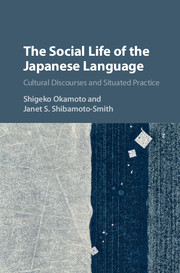Book contents
- The Social Life of the Japanese Language
- The Social Life of the Japanese Language
- Copyright page
- Contents
- Figures
- Tables
- Book part
- Notes on orthographic and naming conventions
- Introduction
- Part I The notion of Nihongo
- Part II Japanese honorifics and Japanese “politeness”
- Part III Japanese language and gender
- Reflections: Looking backward, looking forward
- References
- Index
- References
References
Published online by Cambridge University Press: 05 July 2016
- The Social Life of the Japanese Language
- The Social Life of the Japanese Language
- Copyright page
- Contents
- Figures
- Tables
- Book part
- Notes on orthographic and naming conventions
- Introduction
- Part I The notion of Nihongo
- Part II Japanese honorifics and Japanese “politeness”
- Part III Japanese language and gender
- Reflections: Looking backward, looking forward
- References
- Index
- References
- Type
- Chapter
- Information
- The Social Life of the Japanese LanguageCultural Discourse and Situated Practice, pp. 300 - 329Publisher: Cambridge University PressPrint publication year: 2016

